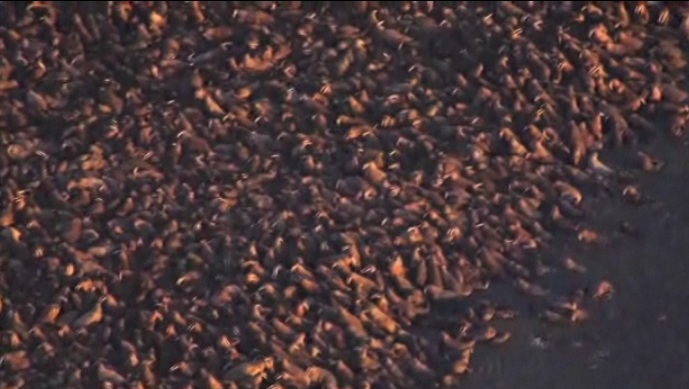
How to Tag a 3,700-Pound Walrus

A new joint effort by American and Russian scientists will offer new insights into the behavior and movements of walruses around the northern Chukchi Sea. But before the walruses can be tracked, they have to be tagged — with a mix of new and old technology.
The American scientists, from the U.S. Geological Service, use a cross-bow to embed a small satellite-linked transmitter into the walrus's fatty back. The tag has a harpoon-head on one end, and the researchers need to get within 10 yards to pull off the winning shot.
At 10 yards, most of the tension comes from waiting for a walrus to be in the best position — lying on its side with its back facing the researcher. That way, the transmitter has the best chance of reaching the sweet spot in the walrus' hide where it will stay for a few weeks or months.
"It's exciting," said Chad Jay, a research scientist with the project. "It's interesting to be that close and really see some of their behaviors and facial expressions at that level. They are big but they're more likely to try to flee than to attack you." Jay said he's become accustomed to being so close to the animals, which can tip the scales at 3,700 lbs.
Transmitters like splinters
The team attached satellite radio-tags on 40 walruses in the northern Chukchi Sea in mid-July and on 34 walruses on the coast of northwest Alaska in late August. Russian colleagues will soon deploy additional tags on walruses on the Russian shores of the Chukchi Sea.
It's important to gather data quickly because the transmitters don't stay in for more than six to eight weeks. The walrus's body works out the device similarly to a splinter, Jay said. “We are trying to work on ways to keep tags on animals as long as possible. Six to eight weeks is fairly short-lived compared to other animal tracking,” he told OurAmazingPlanet.
Sign up for the Live Science daily newsletter now
Get the world’s most fascinating discoveries delivered straight to your inbox.
Jay and the other scientists hope to discover more about how the decline in the coverage of Arctic sea ice in recent decades is affecting the animals' behavior. Each transmitter sends back information about an animal's location and also gives pressure and conductivity (how well a material conducts electricity) readings — data that can let the scientists know each hour if the walruses are hauled out on land or ice, or if they are swimming in the sea. (Water has different conductivity than the air.)
Feeding and Foraging
Though they don't have much behavioral data for walruses from before the ice started shrinking, Jay says that they use reports from aerial surveys to make comparisons.
Walruses feed on sea worms and clams that live in shallow coastal waters. Typically, ice would cover part of the shallow areas and the animals would pull their bulky bodies onto the ice for a rest in between bouts of feeding.
Now, with ice retreating far to the north during the summer and the fall, the animals have to choose whether to haul out on land or not haul out at all. The scientists are examining the questions of how the land haul-outs impact the energy output and mortality of the animals.
Jay says that so far models predict a continued decline in walrus population, but the team has one more field season to deploy transmitters and track the movements of the giant animals.









